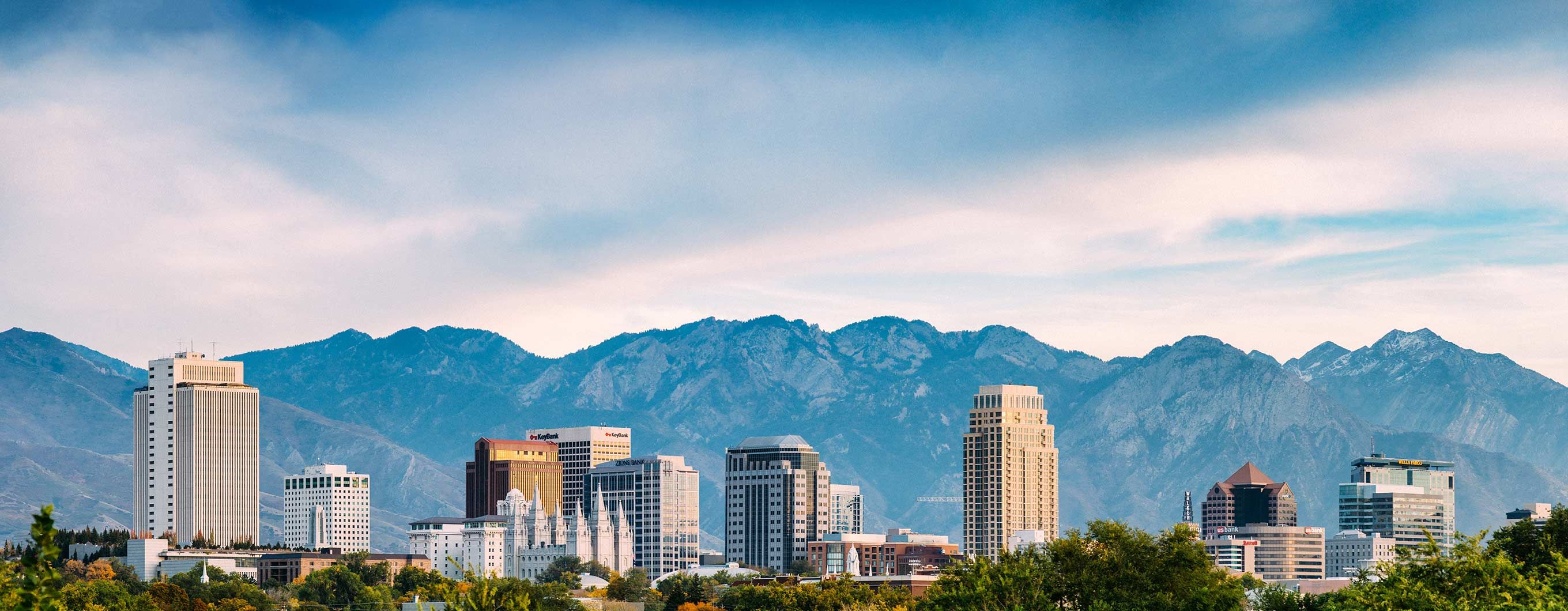
Homeowners Insurance in Utah
Where the dry deserts of the Southwest meet the pine-covered slopes of the Rockies, you'll find some of the most beautiful places in the country. Whether you dwell in Salt Lake City or Saint George, chances are you wake up to a stunning mountain view every day. And, no matter which place you call home, keeping it protected for the long run is important.
Homeowners insurance in Utah helps cover unexpected damages, natural disasters like snowstorms, and liability issues. Whether you buy your first home or have lived in Utah for years, having the right coverage is crucial to safeguard your property and provide peace of mind. .
This article will walk you through everything you need to know about homeowners insurance in Utah, including how much it costs, what factors affect annual premiums, and more.
What is the average homeowners insurance cost in Utah?
The average cost of home insurance in Utah is $1,140 per year, 40% lower than the national average of $1,915.
Insurance companies in Utah and many other states use a credit-based insurance score to determine rates. While this score is similar to the credit score, it is calculated differently and focuses on factors more closely related to insurance risk.
Utah homeowners with a below-average score usually have to pay around $2,415 per year for insurance, 112% more than those with good credit.
Want to know the state's average cost for the last five years?
Below is a table that outlines the average cost of homeowners insurance in Utah over the past five years. However, note that these are state numbers, not city-specific rates.
While State-level home insurance costs can be useful, they often don't capture city-specific variations, which vary greatly due to population density, property values, and local weather risks.
Year | Average Annual Premium |
|---|---|
2021 | $831 |
2022 | $817 |
2023 | $995 |
2024 | $894 |
2025 | $1,140 |
Utah Home Insurance Average Annual Premium
What factors influence my home insurance rate?
The average home insurance cost in Utah varies based on several factors that an insurance company uses to assess risk. If you're looking for Utah home insurance rates, let's look at the factors that could impact your premium:
- Location: Your home's state, ZIP code, and the area's claims history all affect your rate. If you live in a wildfire, flooding, or other risk-prone areas, expect higher premiums.
- Construction: The materials used to build your home determines your coverage costs. If you're building a custom home, you may need additional endorsement coverage to protect the construction site and materials.
- Age of the house: Older homes may have outdated wiring, plumbing, or roofing, which can increase your insurance cost. However, upgrades could help lower your premium.
- Replacement cost: This is the amount it would take to rebuild your home completely. An appraiser typically assesses this value; a higher replacement cost often results in a higher insurance premium.
- Swimming pool: For properties with swimming pools on them, the liability coverage may need to be higher to protect against potential injury claims, which may increase your rate.
- Home-based business: Running a business from home could lead to a higher premium since you'll need coverage for inventory, equipment, and supplies.
- Coverage choices: The type of policy you select and how much protection you want for your personal property and liability coverage will impact your overall cost. More extensive coverage typically means a higher premium.
Common insurance discounts in Utah
Whether you already have home insurance in Utah or want to change your policy, homeowners insurance can be expensive. However, there are several strategies to lower your premium without sacrificing coverage. Many companies offer customers general and exclusive discounts to help reduce costs.
Here are some common discounts the best home insurance companies in Utah offer:
- Multipolicy discount: Bundling your home and auto insurance with the same provider can lead to substantial savings. Some insurance carriers offer up to 25% off when you combine policies.
- Claims-free discount: If you have not filed a homeowners insurance claim in the past three to five years, you may qualify for a lower rate. Insurers reward policyholders who maintain a claims-free history.
- Loyalty discount: Some insurance providers provide discounts to long-term customers. Ask about loyalty savings if you have been with the same provider for several years.
- Advance quote discount: Getting home insurance quotes in Utah before your current policy expires can often lead to a discount. Some insurers reward proactive shoppers who plan ahead.
- Security system discount: Homes with smart features like burglar alarms, security cameras, or professionally monitored systems may qualify for lower rates. These features reduce the risk of theft, which makes your property less risky to insure.
- New or renovated home discount: Newly built and recently renovated houses often qualify for discounts. Modern construction materials and updated systems lower the chances of costly claims.
- Green home discount: If your home has eco-friendly features, such as Energy Star-rated appliances or a LEED certification, you may be eligible for additional savings.
When comparing homeowners insurance in Utah and their rates, check with different providers to see which discounts apply.
Tips for lowering home insurance rates
So, how much is home insurance in Utah per month, and how can you lower it?
While discounts can help you save on home insurance, there are other strategies to reduce your costs. Here are some effective ways to lower your Utah homeowners insurance rates:
- Choose a higher deductible: A deductible is the amount you pay out of pocket before insurance comes in. Opting for a higher deductible could significantly lower your monthly premium. It is important to ensure you have enough savings to cover the cost if you need to file a claim.
- Maintain good credit: Many insurers use credit scores to determine rates. Managing your credit and ensuring timely bill payments could secure lower insurance premiums.
- Review your coverage annually: Always review your policy annually. This could help you avoid paying for coverages you no longer need. Also, bundle your home insurance with auto insurance, which can lead to additional savings.
- Avoid filing small claims: While home insurance in Utah can help you with major losses, frequent smaller claims can cause your rates to go up. If possible, pay for minor repairs out of pocket to keep your premiums lower over time.
- Compare quotes from multiple insurers: Home insurance rates in Utah can vary by company, so don't settle for the first quote you receive. Get at least three quotes to compare pricing, coverage, and available discounts.
What does Utah home insurance typically cover?
Home insurance in Utah is designed to provide financial protection if your home is damaged or lost due to covered events like theft or fire. It also includes liability coverage, which protects homeowners if a person gets injured on their property or if they accidentally damage someone else's home.
That said, here is what a standard Utah home insurance policy covers:
- Dwelling coverage: This insurance policy will pay to repair or rebuild your house after a covered loss. To ensure full protection, it’s recommended to have coverage for at least 80% of your home's total replacement cost.
- Other structures: This helps cover structures on your property that aren't directly attached to your home, such as a fences, sheds, or detached garages. Typically, this coverage is limited to 10% of your dwelling coverage, unless additional coverage is added.
- Personal property: This coverage protects your belongings, such as furniture, clothing, jewelry and even outdoor plants, if they are stolen or destroyed in a covered peril. Many of the best homeowners insurance providers in Utah also offer up to $500 for unauthorized credit card use.
- Liability protection: Liability covers legal fees and settlement costs if you, your family members, or even your pets cause bodily injury or property damage to others. Coverage is provided up to your policy limit.
- Additional living expenses (ALE): Also called "loss of use" coverage, this helps pay for temporary living costs if your home becomes uninhabitable due to a covered event. It can cover hotel stays, rental housing, restaurant meals, and additional transportation costs.
- Medical payments: This insurance policy provides no-fault medical coverage if someone gets injured in your house. This means your insurance will pay for their medical expenses, no matter who is at fault.
The right home insurance means you're protected from unexpected financial losses. It's important to review your policy and ensure you have enough coverage for your needs.
Additional Utah insurance coverage options
While standard Utah homeowners insurance covers many types of damage, certain natural disasters may require additional coverage.
Depending on your needs, you may want to add extra coverage, such as:
- Earthquakes and land movement: Standard home insurance doesn't typically cover damage from earthquakes, landslides, and other ground movements. If you live in an area at risk, adding an earthquake endorsement —or purchasing separate earthquake insurance—can help protect your home. Be aware that earthquake coverage often comes with a high deductible, usually a percentage of your total coverage.
- Wildfires: Most home insurance covers fire damage, including wildfires. However, you should check that your dwelling coverage limit is high enough to rebuild your home if it's completely destroyed. If you live in a high-risk wildfire area, talk to your insurance agent to ensure you're fully covered.
- Flooding: In Utah, floods can occur from melting snow, heavy rain, wildfire aftermath, or flash floods in the southern part of the state. Typically, the standard homeowners insurance policy does not cover flood damage. If your property is at risk, you'll need to buy a separate flood insurance policy. However, you should note that flood insurance usually has a 30-day waiting period before it becomes active, so plan ahead.
If you dwell in an area prone to these risks, review your policy and consider adding the right coverage to protect your Utah home and finances.
What coverage is recommended in Utah?
Due to Utah's unique climate and natural risks, the following coverage is highly recommended:
Wildfire protection:
Given Utah's dry conditions, extra coverage for fire damage may be beneficial.
Extended dwelling coverage:
It helps cover increased rebuilding costs due to rising construction prices.
Earthquake and flood insurance:
These coverages are crucial for homeowners in earthquake and flood-prone areas and zones.
Extended liability coverage:
This type of coverage is helpful if you have high-value assets or entertain guests often.
Insuring your home in Utah
Finding the right home insurance in Utah is critical to protect your property and belongings. Whether you purchase a new home or update your existing policy, understanding the process can help you secure the most cost-effective coverage in Utah.
Below is a step-by-step guide to insuring your home in Utah.
- Assess your coverage needs: Before you shop for a homeowners insurance policy, consider what coverage you need. Evaluate the value of your home, personal belongings, and potential risks such as floods, earthquakes, or wildfires. Most of the top-rated insurance policies in Utah cover common perils like theft, fires, and specific natural disasters. However, additional coverage may be necessary, depending on your location.
- Compare insurance providers: Shopping around helps you find cheap homeowners insurance in Utah. Different insurers offer varying rates and coverage options, so comparing quotes from multiple companies is important. Look for insurers with strong financial ratings, positive customer reviews, and comprehensive policies that suit your needs.
- Check for discounts: Many insurance companies provide customers with discounts that could significantly lower their home insurance costs in Utah. Some general discounts include bundling auto and home policies, installing security systems, maintaining a claims-free record, or upgrading your home's plumbing and electrical systems. Always ask about available discounts before choosing a policy.
- Review policy limits and exclusions: Carefully review your policy's coverage limits to ensure you're adequately protected. Pay attention to exclusions—standard policies may not cover earthquakes, floods, or sewer backups, so you may need additional coverage for these risks.
- Purchase your policy and maintain coverage: Once you find the right policy, finalize the purchase and ensure your mortgage lender receives proof of coverage if required. Reviewing and updating your policy regularly is important to keep up with changes in home value, renovations, or new coverage needs.
Is Utah homeowners insurance required by law?
The state of Utah does not legally require homeowners insurance. However, your lender could require it if you have a mortgage to protect their investment.
Even if you own your home outright, home insurance is highly recommended to safeguard against risks such as fire, theft, and natural disasters. Without coverage, you could experience financial setbacks if your property is damaged or destroyed.
Looking for homeowners insurance in a different state?
If you're looking for homeowners insurance in other states like Texas, Colorado, or Oregon, use the interactive map below to find coverage options across the U.S.
Still have questions?
Want to learn more about homeowners insurance in Utah? Here are some frequently asked questions:
Why is home insurance going up in Utah?
Utah home insurance rates have increased lately due to inflation, rising construction costs, and a higher likelihood of natural disasters like windstorms, hurricanes, tornadoes, wildfires, and earthquakes.
Does Utah have a fair plan?
Utah does not have a state-run FAIR Plan, but homeowners struggling to find coverage can seek assistance through specialized insurers or surplus line carriers.
How much is homeowners insurance in Salt Lake City, Utah?
Home insurance in Salt Lake City, Utah, can vary, but the average premium is approximately $1,150 per year, depending on location, home value, and policy coverage.
How much is Utah condo insurance?
Condo insurance in Utah typically costs around $48 per month or $570 per year, based on the building's location, coverage limits, and personal property protection.
How much is mortgage insurance in Utah?
Mortgage insurance costs depend on the loan type, down payment, and credit score. PMI for conventional loans ranges from 0.5% to 1.8% of the loan amount annually.



